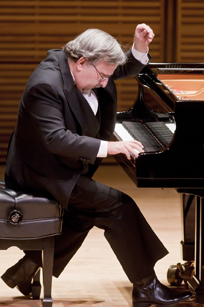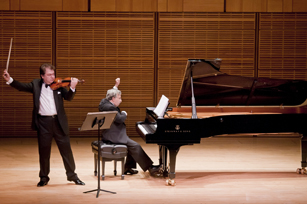Şahan Arzruni, piano
French Institute Alliance Française-Florence Gould Hall, New York, NY
April 5, 2019
Turkish-born Armenian pianist Şahan Arzruni gave an important and deeply felt recital April 5 in the intimate Florence Gould Hall of the French Institute/Alliance Française, and it was in works by Armenian composers that he was most colorful and convincing. Marquee names Hovhaness and Khachaturian were present, but so was the relatively unknown Edward Mirzoyan. Come to think of it, one doesn’t often hear music by the “marquee” names either, so this recital served an important musical as well as patriotic function. A nearly full house of enthusiastic supporters seemed to thrive on the life assertion of a culture that was nearly eliminated in 1915 by a deliberate genocide planned by the Turks.
The recital began with a generous helping of works by Chopin, however. Here, Mr. Arzruni exhibited great dexterity and a very personal rubato and flow, as well as heartfelt commitment, in two impromptus (Op.29 and Op. 66) and three nocturnes (Op 9, No.1 &2, Op.32, No.1).
He then turned to music by Alan Hovhaness, with verbal remarks that clarified what was about to be played, stating that Hovhaness could be regarded as the “first minimalist,” so much of his piano music consists of single-line (or very lightly supported) melody. Don’t let the phrase “single line” fool you; the music abounds in subtlety and rhythmic surprise, and Mr. Arzruni created vivid, eloquent atmospheres, even with these “limited’ means. In Vanadour: Armenian God of Hospitality, Op. 55, No. 1, the pianist is actually imitating the oud (similar to the Western lute). Farewell to the Mountains, Op. 55, No.2, displayed again the maximal result of such slender writing. Achtamar (sometimes spelled Akdamar), Op. 64, was inspired by an island in Lake Van, the largest lake in Turkey, with the Cathedral of the Holy Cross and a tenth century monastery that were spared from demolition (three others were destroyed). Hovhaness joked (or was he joking?) that it was “composed by the cat,” Hovhaness’ cat Raja Hoyden.
After intermission, the old chestnut Toccata (first movement of a largely forgotten three-movement suite) by Aram Khatchaturian was given a propulsive reading full of abandon when appropriate, making the most of the lyrical moments that are also in the work. Armenian folk melodies and rhythms form the raw materials of this dazzler. After this master rendition, one never wants to hear it played by a student pianist again!
Thereon followed a small suite by Edward Mirzoyan (1921-2012), a Georgian-born Armenian composer who was previously unknown to me, although in his day he was regarded, right along with Khatchaturian and four others, as a leading light. The suite, inspired by and dedicated to his granddaughter Mariam, could easily take its place next to Debussy’s Children’s Corner and Schumann’s Kinderszenen as an adult’s “view” of childhood. Mr. Arzruni was absolutely authoritative—he knew Mirzoyan—and particularly haunting in two movements titled Meditation and Sad Waltz.
The recital closed with a performance of the most famous sonata of all time, Beethoven’s so-called “Moonlight.” Once the audience hears the all too familiar first measure of triplets at the beginning, it really ceases critical listening, and far be it from me to be too hard on this performance. The sempre pianissimo delicacy and pedaling required by Beethoven were not present, and the triplets were consistently distorted to “fit in” the sixteenth note, something we tell all our students not to do, yet I found myself pulled in to the interpretation because Mr. Arzruni was so convincing in his concept. The Allegretto “flower between two abysses” was nicely delineated, and the tempestuous finale thundered appropriately, with some extremes of rubato that even scholars are beginning to admit “may” have been more commonplace in Beethoven’s time than we are willing to admit. I just felt that the time could have been better used to present even more rarely heard Armenian music (perhaps some Komitas).
Mr. Arzruni received a standing ovation, well deserved, and he played two unannounced encores, neither of which I knew, though the first sounded like Hovhaness to me, and the second a bit like Mirzoyan, or was it a touch of Arzruni?




